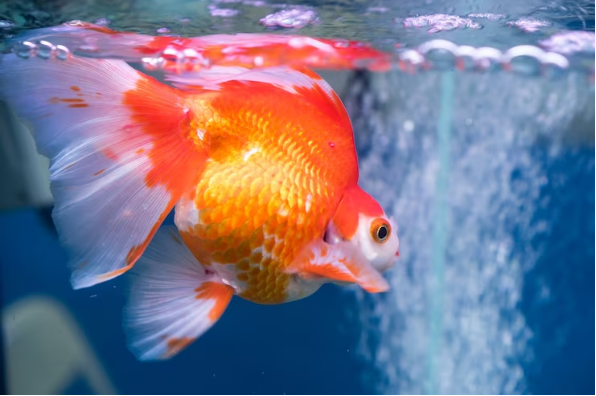We have previously discussed how long do goldfish live, but many are confused as they failed to keep them alive. For that, understanding the topic of how to take care of a goldfish is necessary. So, let’s see what we have hidden in our magical box.
If you have a goldfish, then as a goldie pet owner, you better know that your finny friend requires a lot of care and attention to be safe and healthy and be with you for a longer time. It is a medium-maintenance pet but not a trial pet that you can give to beginners to care for.
Goldfish need proper care like feeding, tank size, health, as other aquarium fish do. A little mistake can take away from you your finny friend in a while. Therefore, if you have this beautiful little water creature in fish tanks as a pet, here we summed up some instructions on making your fish happy and healthy for years. So, keep reading our guide about how to take care of a goldfish.
How To Take Care Of A Goldfish
The first thing is to remember to buy a healthy goldie from a pet shop. While other common and prominent ways to take care of a goldfish are as follows:
Goldfish Tank Requirements
Putting goldfish in a bowl or a small tank is not a good option; instead, some specific goldfish tank requirements will accommodate their growing bodies. Healthy goldfish live up to 20 years.
We can enjoy our life with our goldie for these 20 years if we fulfill tank requirements like tank size according to a goldfish type, including common and fancy goldfish and many other finny breeds. Living in a bowl is not ideal; therefore, we discuss the perfect size for aquarium fish.
Tank Size
The minimum tank size for one goldie is about 20 to 30 Us gallons (75.7 to 113 liters), and each fish needs at least 20 gallons of water.
If goldfish cannot get maximum space, a survival mechanism starts, and they will stop growing, but their organs do not, which causes compact size, with bloating of organs inside the body and suffocation issues. Find another fish type if you can’t provide an appropriate large tank size.
There is a need for 56.8 liters of more water, equivalent to 15 U.S. gallons, to add another goldfish to the aquarium. Single-tail and comet goldfish need huge tank size to grow up to a foot or length. You need 1800 gallons of water, around 681.4 liters, or a pond for these goldies because they get too large.
The minimum tank size required is about 50 L and with the following dimensions:
Length = 4 x (4 to 8 to 12 inches) adult goldfish body length
Width = 2 x (4 to 8 to 12 inches) adult goldfish body length
Height = 3 x (4 to 8 to 12 inches) adult goldfish body length
Temperature
As a Goldfish pet owner, Ayush Shah, from Pets Nurturing, exclusively tells PetInfoMax that Goldfish are cold-water fish and prefer a water temperature between 65-70°F (23°C). If you do all this, I’m sure your goldie will live a long, happy, and healthy life. Do goldfish need a heater? The answer is yes; you can use a tank heater when the temperature goes below normal. Change the temperature according to seasonal changes as in winter; the temperature should be between 10°C – 12°C, and in summer, it should be 20°C – 23°C.
Oxygen Levels
If your goldfish comes on the water’s surface, that does not mean there isn’t enough water; instead, it means the oxygen level is down in the aquarium. Oxygen levels may increase by temperature reduction.
You can manually lower the temperature and avoid sun exposure in the aquarium. The temperature will be down using this method, but if not, you can get a bubbler or an air pump to move water.
Water Quality
In addition to tank size, better water quality is also essential for every goldfish aquarium. Test water quality by ammonia and nitrate (also nitrate) to check whether biological filtration is working. Some water parameters to keep an eye on PH, GH, KH, and water temperature are as follows:
- Ammonia less than 0.1 ppm
- Nitrite less than 0.2 ppm
- Nitrate less than 50 ppm (tolerance is less than 110 ppm)
- Keep the pH between 6.5 and 7.5; however, the tolerance range lies between 5.0 and 9.0
- Keep KH of water between 70 and 140 ppm. It stops the sudden change of pH and death of your goldie.
- General hardness 150 ppm
- Keep the temperature between 20 and 24°C; however, tolerance range lies between 8 and 30°C
All the dirt and physical waste build-up is never seen with the eye; therefore, water test kits are required to test the residual build-up in the aquarium.
Do Goldfish Need A Filter
Paola Cuevas, a Veterinarian, MVZ, and Behaviorist with petkeen.com, suggests that your water tank should have a filter to process the waste and help to keep the water clean. A biological filter is a good one with beneficial bacteria to keep the good water quality.
Cycling Fish Tank
First-time fish owners should remember to cycle their fish tank before bringing their new pet fish home. Once the fish tank is cycled, check the tank’s water quality, which is discussed earlier in detail. Tests should be done on a weekly basis before you do a water change.
Goldfish Tank Accessories
Goldfish pick up gravel with their mouth and spit it out, and they love it; thus, choosing a substrate larger than their mouth is ideal so that it cannot get stuck in their mouth or ingesting it. The best thing you can do is to select sand that cannot get stuck in goldies mouth.
Aquarium lighting is a good idea if your aquarium is in a dull area or has real plants. It is another best Goldfish tank accessories. Avoid placing an aquarium in the sun because it raises water temperature, which is unsuitable for goldfish.
If you incorporate live plants into their tank or pond, your goldfish will benefit from a visually appealing environment and comfortable living conditions. It oxygenates water, and goldfish will enjoy these certain types of plants. Artificial plants are preferred because they will be easy to maintain and cannot be easily destroyed by goldfish.
Tap water is unsafe for your finny friend because it contains chlorine and other chemicals irritating fish, but a water conditioner makes it ideal and safe for goldfish.
Feeding System
Paola Cuevas, a Veterinarian, MVZ, and Behaviorist, exclusively tell PetInfoMax that “choose a high-quality fish food for your goldfish diet; a species-appropriate diet for a goldfish is food prepared for omnivorous fish.
Provide variability and add to your goldfish diet a couple of times a week. Goldfish eat Brine shrimp, mosquito larvae, daphnia, tubifex worms, and bloodworms make great protein-rich foods to keep your goldfish healthy. Plant-based foods like algae wafers, de-shelled peas, romaine lettuce, carrots, and cucumber can be fed to help with digestion and promote variety within the diet.”
Be careful about what you feed your goldfish; Goldfish are Omnivores and greedy, too, so don’t overfeed them because overeating may become a cause of their death. Soak them in water before feeding them if you are using floating food. Reduce the amount of air that goldfish swallow while eating, reducing buoyancy issues.
According to Jordan Woolf, founder of Aquarzone, “feeding them twice a day and only giving them what they can eat in two minutes is preferable. Overfeeding can lead to health problems.”
Health Problems
Goldfish easily fall sick if you don’t care for them properly. A sick fish does not come from an ideal condition, and everything worsens when you add a new fish without isolating them. Sometimes goldfish become immediately ill after bringing them from the pet stores.
Detecting the disease in an early stage becomes half cure, and you may get more chances to save your goldie.
One factor that contributes to goldfish illness is an inappropriate fish tank environment. So it is essential to keep a check on the water all the time. It appears clean at first glance but may be toxic for pet goldfish. Goldfish produce so much waste that water will eventually turn poisonous and harmful.
The second common condition is parasites, fungal disease, and bacterial infections that will ravage your poor goldfish. All these diseases consume your fish as it continues to keep in a disgusting environment. You can control the situation if you detect it early; then, your Carassius Auratus will still live for many years with you.
If your fish is swimming sideways or even upside down, it means it is suffering from swim bladder disease. You don’t need to quarantine your fish because it is not a parasite. Medication is also not needed because it is because of improper feeding.
Reduce the amount you are feeding your goldfish and put them on fast for a few days to reduce the disease. If symptoms persist, you should consider changing their diets, including peas, cucumber, and high-fiber foods. You can also use medicated food in the goldfish diet to treat internal infections.
Can A Goldfish Get Along With Others?
One of the most challenging steps is to choose the best mates for this freshwater fish. Goldfish are very particular about their mate compared to other tropical fish species. Fish tank mates should have several traits.
The environment is one of the most critical factors for the fish to survive. Remember not to place too many fish in one tank, which causes congestion and a decline of oxygen in the water that causes the death of your goldie. Every new fish entering the fish tank should have a diet and temperature tolerance similar to the already available fish.
Speed plays a vital role in selecting tank mates because if we add faster fish, they will consume all the food before fancy goldfish can eat. Among varieties of goldfish, fancy goldfish are slower and cannot survive in this tank water.
Goldfish grow faster, and putting smaller fishes with large ones creates problems because the smaller one becomes prey to the bigger ones, irrespective of tank size.
Final Words
Goldfish is an excellent pet for your aquarium, but it needs special fish care so you can live happily with your goldie for a long time. All the steps to answer the question of how to take care of a goldfish are discussed in this topic.
I hope this article will help you take care of your ornamental fish more appropriately, and you will come up with good news in the future that your goldie is living fine and healthy.






![Turtle Tank Setup: The Ultimate & Step by Step Guide [2023] Turtle Tank Setup](https://petinfomax.com/wp-content/uploads/2023/03/Turtle-Tank-Setup-100x75.jpg)
